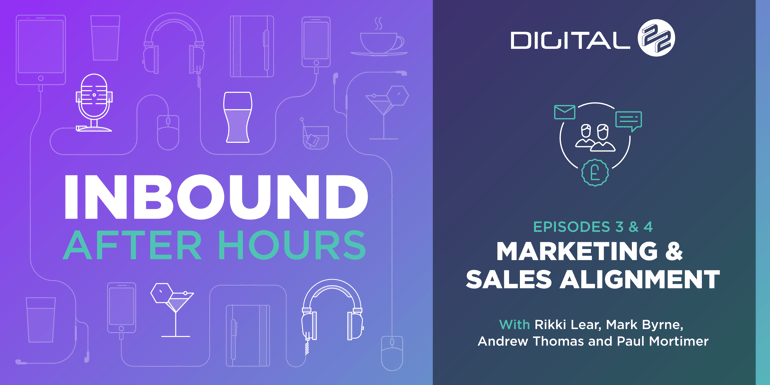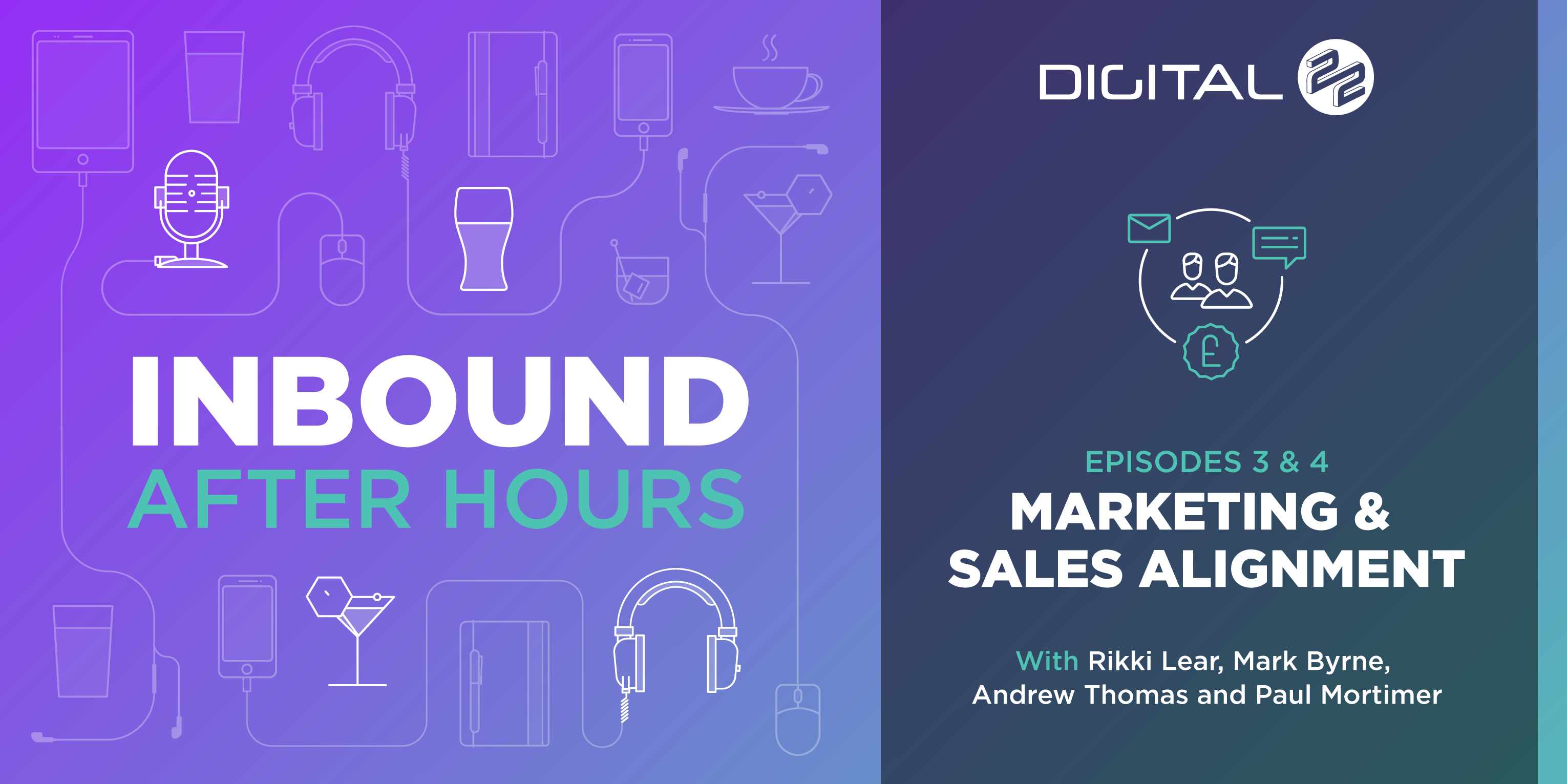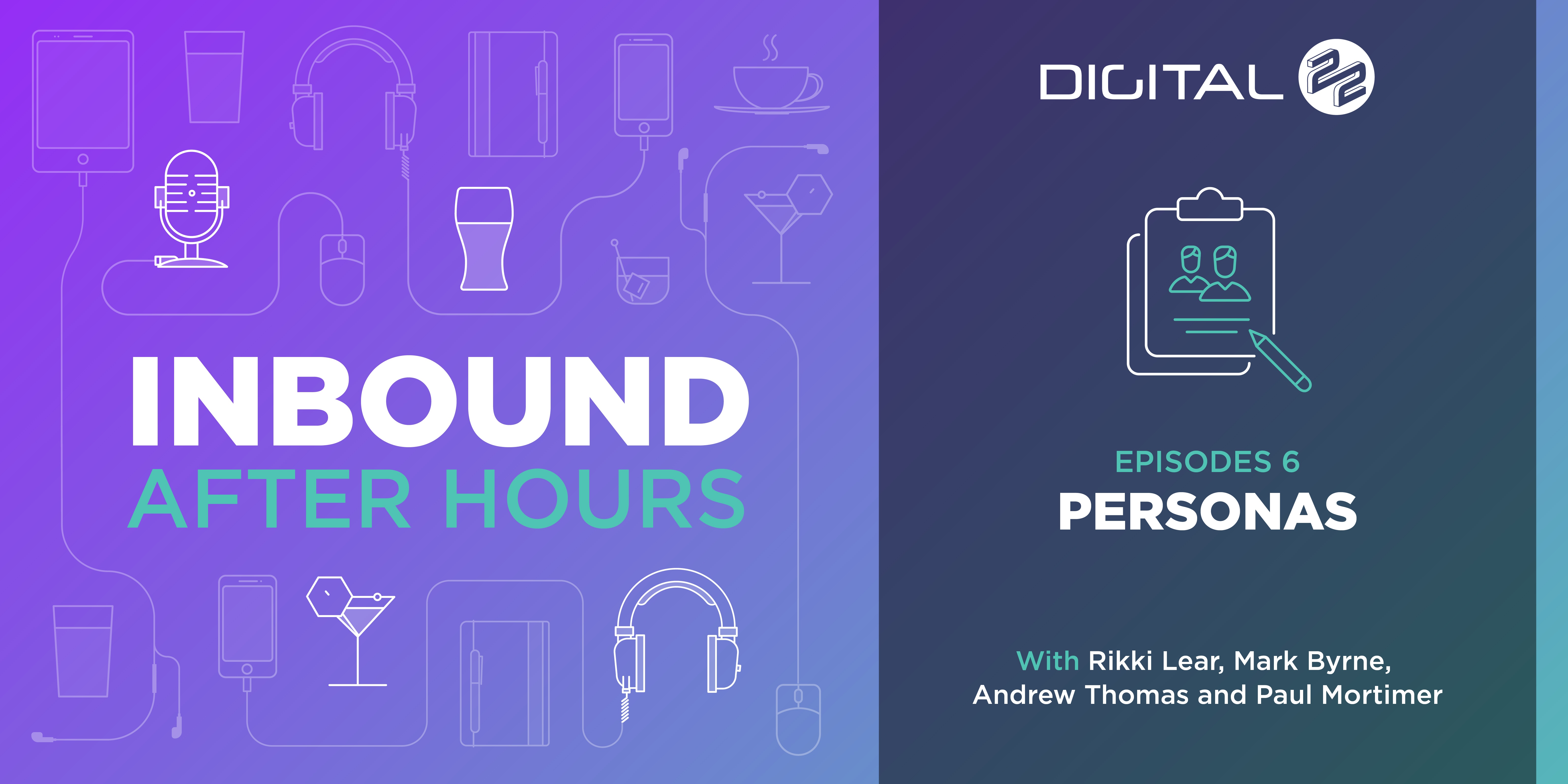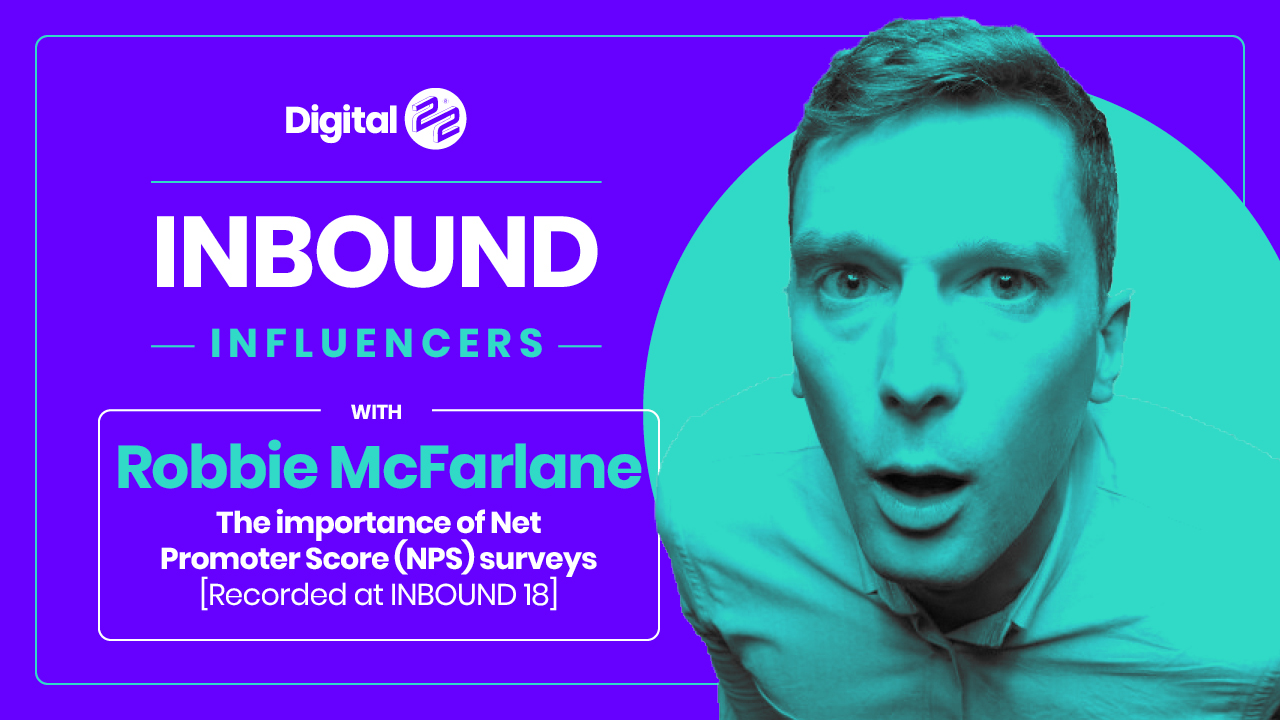This week on Inbound After Hours we have a special guest, Diarmuid Walsh, from HubSpot, and a...
This week we have the conclusion of last weeks episode featuring special guest, Diarmuid Walsh, from HubSpot, with a discussion on how sales and marketing must be aligned for the best results.
Let us know what the successes (and challenges) you have had in aligning sales and marketing in the comments below.

In this episode we will discuss:
- Why sales and marketing must be aligned for maximum success
- How much of the buyer experience marketing should control
- Tips for marketers approaching sales teams
- The power of the sales process
Watch...
or listen...
Show notes and resources mentioned in this episode:
- The free conversion funnel template (part of the inbound starter pack).
Thanks so much for joining us this week.
Have some feedback you’d like to share, do it in the comments below!
Full transcript:
-Welcome to part two of the Sales and Marketing Alignment Podcast with special guest Diarmuid Walsh from HubSpot.
- I wanted to say to marketers today, as well, that sometimes the fastest way to speed up a sales process is actually to slow it down, and what I mean by that is to push back. So, if you feel that you're not getting the information that you need to move forward, you need to be clear with the prospect and say, listen, I need to understand-
- For example, you may have an example where a prospect doesn't, at this stage, want to share with you revenue projections, or what the current revenue is. They feel that, no, no, I don't want to do that. How can we ultimately help if we don't really understand where they want to get to in terms of revenue? We need to understand what the revenue is today, and where they need to go to. And you need to then, if they're not willing to share that information, you need to explain, first of all, why you want that information, why you need that information, and if they're still not willing to share, it's a case of, listen guys, there's no point moving forward until you are willing to share that information. And that's a case of pushing back, slowing the sales cycle down, and making them realise we're here to help, but you need to share with us that information.
- Going back to the car dealership analogy, it's asking that dealer, come on, what's your best price? And you know, you can afford 200 a month. They're going, no, it needs to be 120. Then they're like, what can you really afford? 120. And he's like, you can't really-- you can afford more than that. Forget it. We're never gonna meet your price. When really, if he'd have just gone, 118, well, yeah, fair enough.
- Yeah, it's a really interesting shift in sales, isn't it? How marketing adapts and get into that. I think it's really worth a marketer's time, and we do this a lot as an agency, getting in the room with salesmen, and this time didn't have that funnel, how many leads they need to ultimately do enough pitches, to ultimately win enough customers, to ultimately hit that revenue goal. With the amount of companies that don't have that funnel is quite amazing.
- What percentage of companies that you've dealt with have that information? - I have not been to one yet that has it, and we've been doing this for--
- Five years.
- Five years plus. I've honestly never been to--
- They could have a sales team bigger than our whole company, and they still don't have that, we've seen.
- No.
- All salespeople should know what their methods are. For a salesperson to be successful, a really good salesperson will have a plan made out at the start of the year, in terms of what their goal is, that are broken down in terms of quarter. Then, they'll be able to reverse engineer, assuming they have a very structured sales process. So, if I bring onboard one new client per month, I need to have two proposals, then I need to have five or six goal-settting calls, then I need to have 15 discovery calls, then I need to have 30 connect calls, then I need to have maybe 90 leads, and then I need to have an understanding of where those leads are coming from.
- And that's where, sorry to muck in, that's where I think the value is for marketers, because once you know that lead number, you can take that funnel further back. So, you can go, these guys need 100 leads a month. That means I need to give them 150 contacts because I know half of them will be the wrong fit, the other side of the world, using Gmail email addresses, et cetera, they won't be the right fit for us. So, we've got to do 150 contacts. If we need 150 contacts, and our website closes at three percent, don't know maths, by the way-- -
-five thousand. That's bullshit. You know that you need 5,000 visitors a month to ultimately fill that funnel. That's why I was saying, that's where it's worth you, as a marketer, sitting in that room, doing it with sales,, because ultimately it affects your own metrics. Then, what you can do that's even better, as a smart marketer, is say, right, those are the metrics we need. Ultimately, we need to know the revenue goal, and you can start to understand what all those things mean in revenue, so you know a contact's worth 20 quid, you know a lead's worth 40 quid, you know a connect call's worth 50 quid, et cetera. You can work all that out so when you are doing Facebook ads, BBC ads, you can figure out if your cost for acquisition for the contact is higher or lower than what you need to make money at it, at the end of the day.
- Kinda relies on the pawnship angle again, though, doesn't it? You don't want the client's sales to be 90 percent of all--
- That's my very favourite answer to that question: what is your close rate? Give me the leads, I'll close them all. How many salespeople say that? I say, look, if I use your logic, and I do this funnel, our close rates will--.
- I think, as well, because so many companies don't have that insight into their data, this is why you, as an agency, are in a really good opportunity because it's beginning to have those conversations with business owners, with marketing directors, with sales directors, getting them to think-- guaranteed, they've all wanted to do it, they've all maybe tried to do it, and just business has gotten in the way. Day-to-day life has gotten in the way. They don't have the technology set up. So, the great thing is that you can begin to implement the inbound methodology. It will take time, but then you can always review it every three months, six months, and essentially every quarter, and review, but constantly understanding what the breakdown is, in terms of those actual metrics. - Because, like you said, it's a number's game, at the end of the day. If you're not hitting those funnel numbers, you can quickly look back and see where you're going wrong. So, it's like we're getting 5,000 visitors, but we're not getting 150 contacts. We've got a conversion issue. We're getting 150 contacts without turning into 100 leads, you've got an issue with quality of leads coming into your site. By having all those metrics, and similarly in sales, I could get into the end of that and close my file, and disqualify so, I'm pitching unnecessarily. By having all those metrics in place, when something goes wrong, you're not all sitting on your tails, saying, hey guys, where have we gone wrong? You sat around, and you can say, right it's this phase where we're going wrong. Let's all work together on fixing that phase.
- Yeah, no, for sure. The great thing about it is there's nowhere to hide, and because there's nowhere to hide--
- People don't like that.
- Well, some people don't like it, but the great thing about it is, the people who are, generally, already good at their job do like it, and ultimately, it's the people who are really good at their job who you want to keep happy. Because you want to be giving those the credit as opposed to somebody who isn't good at their job and getting all the credit. So, there's nowhere to hide. Using a technology like HubSpot, everything, it's clear as day, it's completely transparent, and, ultimately, not only can you see the problems in terms of the funnel, but you can also quickly find, okay, we're generating 500 leads per month, we have five salespeople, there's a hundred being rotated to each different person. The buyers and owners typically are the same. You can quickly identify which salespeople are typically more skilled than others, and in addition to that, it can identify why are they not closing as much as their peers? Is there a breakdown in relation to their sales process? Do they need to practise in honing another ticket or skill, whether it be around the discovery call, or the connect call, or whatever it may be.
- What we were talking about on the car ride down, by having those figures, you can also scale. So, if you know you get 500 leads, 100 leads a salesperson, when you start getting to 650, you might think, right, we need another salesperson, and you can start scaling your business that way, based on metrics.
- Essentially, HubSpot, we very much are our own best case study. We grow our business through enviromarketing. I'm not sure of the exact numbers. I'm gonna take a guess here, I could be wrong. I think it's around 50,000 plus leads per month that we're generating as a business, and that's growing all the time. But the company knows what the conversion rate is, in terms of those number of leads, it knows how many new customers we would expect to have at the end of each month, at the end of each quarter. So, it knows that we need to ultimately invest in certain areas of the business to continue that level of growth. So, it's a really prudent model that works. - What exactly is the conversion rate? Will you tell us, do you know?
- Don't know.
- No idea.
- HubSpot, as a company, we're growing at 15 percent every year. We went public, I think, October, 2014, at a valuation of around $800 million. We're about two and a half billion dollars today's valuation.
- Wait a second.
- A couple of pounds beyond.
- But the interesting thing is, the company is hoping to achieve a billion dollars in annual revenue by 2020. The reason it's confident it can say that is because they have a very prudent methodology in place for marketing and sales.
- To build more trust for investors and more money to do things.
- One of the big problems will be, in maintaining that level of growth, you have to hire an awful lot more people--
- Skilled people, yeah.
- I think that'll probably be our biggest challenge, as opposed to, actually, where are they generating leads. Because, as we all know, with inbound marketing, it takes time to get found, but once you build that authority, once you have a really strong publishing network, whether it be through an agency or your own in-house team, you can begin to get found for the relevant long tail keywords that you want to get found for, and just continue to generate more and better quality leads all the time.
- The analogy I use there is, with inbound, you buy in, so if you look at it like property, you're buying your house, you know, build for future, you're gonna own that at the end of it. Whereas when you rely 100 percent on PPC or advertising, you're renting, and as soon as you stop putting those pounds in, it's gone. Your whole streams are gone. And that's the beauty of inbound is, it does take a lot. - Did you make that up?
- I think so.
- Who's writing?
- If you take your PPC off, you stop. It's not sustainable. Where inbound is almost like,
- Yeah, it's an organic process.
- The piece of content that HubSpot generates its most leads from-- now, the problem with this is that nobody knows what piece of content is really gonna do that until you actually publish it.
- Yeah, we've found that, definitely. - But the piece of content was, it's targeted towards our Marketing Mary.
- Yeah.
- And a Marketing Mary persona, will be a female marketeer, busy person, mid-level in organisation, probably about 50, or so, employees. Very busy job, but works in marketing, but also tasked with doing other activities, chores for the business, and one of those would be writing a press release. You know, can you write a press release? So, HubSpot identified this and they created a template of "How do you write a press release?" If you type into Google "How do you write "a press release?", in the top three or four organic search results you will see the HubSpot blog "How do you put out a press release?" and that, I don't know how many thousands of leads that generated for them, but it's been a huge quantity of leads, and just as you said there, with inbound marketing, you're creating content that you can get found for, essentially, forevermore.
- Yeah.
- You're never gonna turn that tap off. But I would say this, it does take time, and businesses ultimately need a lot of the time when they engage agencies, they need leads now because they're potentially struggling to hit a particular goal. Sometimes PPC can be a really good way to work to boost that session for the first three or four months, and then after three or four months, all that inbound machine is kind of cracking for you, getting found for that particular content, and then begin to turn it off.
- Like Andrew said, I think it was on the first podcast, when you said about using PPC, as well, and not just for getting in some quick wins, but also to learn, for inbound companies.
- It's a great way to get engaged with it, so yeah, just strategy.
- Yeah, it's good for that.
- We've touched on, they're also paying social ads, as well. We touched on that in the last podcast.
- You know they say, I mean, I've heard a lot of expert marketeers talk about the power of Facebook, and so many organisations aren't using it yet. So potentially may be a company to invest in, to invest in it, because it looks like their cost of their advertising will probably greatly increase over the next two or three years.
- It'll be where Google Adwords is now, in a year, so this is the value now. We've talked about this, pretty much, on every single podcast so far.
- It's working great for us.
- Sh.
- It's for our clients, but this is why we do the podcast, to share, share the wealth. Let's talk about resistance, then. So you've got, you've got sales, you've got marketing, old school, you got guys that have been in sales for 40 years, on a separate account. "I don't want anything to do with them guys." And suddenly we're trying to bring these together. We're getting resistance, and I'm sure the listeners are, as well. Have you got any tips and advice how we can get these guys on board or work together?
- How marketers approach sales, 'cause it is wicked. It's a weird situation. We've talked about this recently. You're going in as a 30-year-old marketer telling a 55-year-old sales director how to do sales. And that's not obviously how we approach it, and I'm sure Diarmuid's gonna say, don't approach it that way. But it's quite interesting, as a marketer, how you go to sales and say, you need to change because of these things.
- I think I wouldn't necessarily use the term "you need to change." I would more try and approach it from a workshop standpoint, and base it around education. And base it around sharing case studies and actual numbers and potentially getting those legacy sales directors to engage with sales directors who are their peers and who've been in the business a long time, and having that kind of reference conversation, or potentially recording that, what we're doing now, or having a podcast with sales directors who may have engaged this new process, that are seeing real value, record it, and then send it out to these people. But it is, I think, the best way to educate so many, in most cases, legacy people is typically to get them talking to other legacy people who've actually changed and seen value.
- A tactic we've had recently is where I've been going to the top and trying to get them to drill down. Pick a sales exec, use them if they're up for it. Show them how you can manipulate their numbers, get their numbers up, and then when, all the sudden, this sales exec starts closing a lot more than the rest of the team, that's when people start to take notice. And that's a quick in. 'Cause normally you talk to a guy of a similar age, he's up for it 'cause he's new and he just wants the end results to impress his boss and we found a few cases where you do get resistance at the top, go in at the bottom, make him a super hero. Everyone else will want what he has.
- Yeah, 'cause they'll just talk, like you said earlier.
- Yeah, they do, particularly in sales, as well. - Education is absolutely key. What we always say, because inbound is a relatively new concept, and because change everything is changing so fast. You need to always be educated, both yourself and your clients. And I think that's probably one of the big challenges today and into the future, is keeping on top of what is actually changing. Because everything is changing so fast.
- I think it's a big pat on the back for anyone who's a marketer, who's doing inbound, who's watching this, who's involved, because you're one of the, I don't know what the saturation point of inbound is in the UK, but you're one of the three to five percent who are in it, who are doing it. Other people haven't even started this process, so I think it's a big pat on the back that you're in it and trying it, you're doing it. 'Cause it's still so young, isn't it?
- Yeah, but the great thing about inbound, as well, the four key pillars are attract, so driving the correct audience to your website, convert, knowing who they are, getting them to convert on your website, downloading contacts, so we can find out their first name, their last name, what their email address is. And then beginning to market to them, and then, ultimately delighting them into becoming a customer, becoming thought leader. So that's the methodology. Then you need to ask, what challenges are they actually solving? It's ultimately solving companies that have paying points around, there's nobody coming to their traffic, or there's traffic coming to our website, but we don't know who's actually coming to our website. Or there's people converting on our website, but it's entirely the wrong type of lead. Or you could have the business owner who is getting fed up with the marketing director, who's constantly looking to increase budget in their marketing. Typically, they may be spending three to five percent of annual revenue. The business owner's tearing his hair out. He or she is saying, show me the value there. Show me the proof that this is working. And with marketing, it's very difficult in many cases to prove that exactly, but the beauty about inbound marketing is that, and particularly using HubSpot to deliver inbound marketing, is that you can prove that all the way, right down to the very last penny that they spend. They're the problems, and the question is, how many companies have those problems? The reality is, the vast majority of companies out there have those problems. The question is, do they want to address those problems today or ever? But ultimately, that's your job, as an agency, is to try and find those companies, deliver value. But the question is, which companies actually want to address it today? But the reality is, the vast majority will have those problems.
- We wrote a blog recently that said, if you want to become the super hero in your company, and you want to be the marketing person that really stands out, you've gotta ultimately solve one of the problems the business has, which are all the parts Diarmuid told you. I've not got enough traffic, I've not got enough leads, I've not got the right leads, or I've not got enough of the right leads. And if you solve one of those four problems that pretty much every business has, that's where you excel in your role, that's how you get the promotion, as an in-house marketer. That's what, me going out, talking to prospects, that's how we talk about it, isn't it?
- Yeah.
- I agree, Rikki. Just to help the viewers out, everything you spoke about regarding sales and marketing, we've actually built some editable templates. We spent a whole lot of time doing these. We're gonna put them in the show notes and you guys can download them free of charge. Am I all right, giving that?
- They're unplugged.
- They're unplugged?
- They're templates for what?
- For the sales and marketing--
- Yeah, it's literally what we go through, which is, figure out your customers and work that back through leads, pitches, et cetera, right the way to visitors. If you put the percentages in on the side, you can work down the right-hand side.
- So this sounds
- Yeah, exactly. Put percentages in.
- So we'll have them in the show notes. I really enjoyed this podcast today. Probably my favourite one, and it's made me realise that we probably need to get some more guests in.
- Yes.
- Again, thank you for watching. Any feedback, please put in the comments, please share. We're gonnaand again, let's leave it at that. Thanks guys, take care. Bye bye, now.




